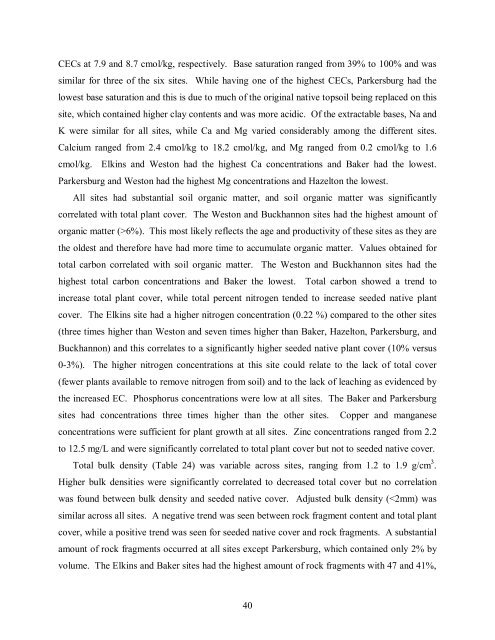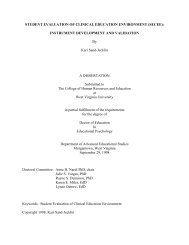The Use of Native Plants for Revegetation along West Virginia ...
The Use of Native Plants for Revegetation along West Virginia ...
The Use of Native Plants for Revegetation along West Virginia ...
Create successful ePaper yourself
Turn your PDF publications into a flip-book with our unique Google optimized e-Paper software.
CECs at 7.9 and 8.7 cmol/kg, respectively. Base saturation ranged from 39% to 100% and was<br />
similar <strong>for</strong> three <strong>of</strong> the six sites. While having one <strong>of</strong> the highest CECs, Parkersburg had the<br />
lowest base saturation and this is due to much <strong>of</strong> the original native topsoil being replaced on this<br />
site, which contained higher clay contents and was more acidic. Of the extractable bases, Na and<br />
K were similar <strong>for</strong> all sites, while Ca and Mg varied considerably among the different sites.<br />
Calcium ranged from 2.4 cmol/kg to 18.2 cmol/kg, and Mg ranged from 0.2 cmol/kg to 1.6<br />
cmol/kg. Elkins and <strong>West</strong>on had the highest Ca concentrations and Baker had the lowest.<br />
Parkersburg and <strong>West</strong>on had the highest Mg concentrations and Hazelton the lowest.<br />
All sites had substantial soil organic matter, and soil organic matter was significantly<br />
correlated with total plant cover. <strong>The</strong> <strong>West</strong>on and Buckhannon sites had the highest amount <strong>of</strong><br />
organic matter (>6%). This most likely reflects the age and productivity <strong>of</strong> these sites as they are<br />
the oldest and there<strong>for</strong>e have had more time to accumulate organic matter. Values obtained <strong>for</strong><br />
total carbon correlated with soil organic matter. <strong>The</strong> <strong>West</strong>on and Buckhannon sites had the<br />
highest total carbon concentrations and Baker the lowest. Total carbon showed a trend to<br />
increase total plant cover, while total percent nitrogen tended to increase seeded native plant<br />
cover. <strong>The</strong> Elkins site had a higher nitrogen concentration (0.22 %) compared to the other sites<br />
(three times higher than <strong>West</strong>on and seven times higher than Baker, Hazelton, Parkersburg, and<br />
Buckhannon) and this correlates to a significantly higher seeded native plant cover (10% versus<br />
0-3%). <strong>The</strong> higher nitrogen concentrations at this site could relate to the lack <strong>of</strong> total cover<br />
(fewer plants available to remove nitrogen from soil) and to the lack <strong>of</strong> leaching as evidenced by<br />
the increased EC. Phosphorus concentrations were low at all sites. <strong>The</strong> Baker and Parkersburg<br />
sites had concentrations three times higher than the other sites. Copper and manganese<br />
concentrations were sufficient <strong>for</strong> plant growth at all sites. Zinc concentrations ranged from 2.2<br />
to 12.5 mg/L and were significantly correlated to total plant cover but not to seeded native cover.<br />
Total bulk density (Table 24) was variable across sites, ranging from 1.2 to 1.9 g/cm 3 .<br />
Higher bulk densities were significantly correlated to decreased total cover but no correlation<br />
was found between bulk density and seeded native cover. Adjusted bulk density (












